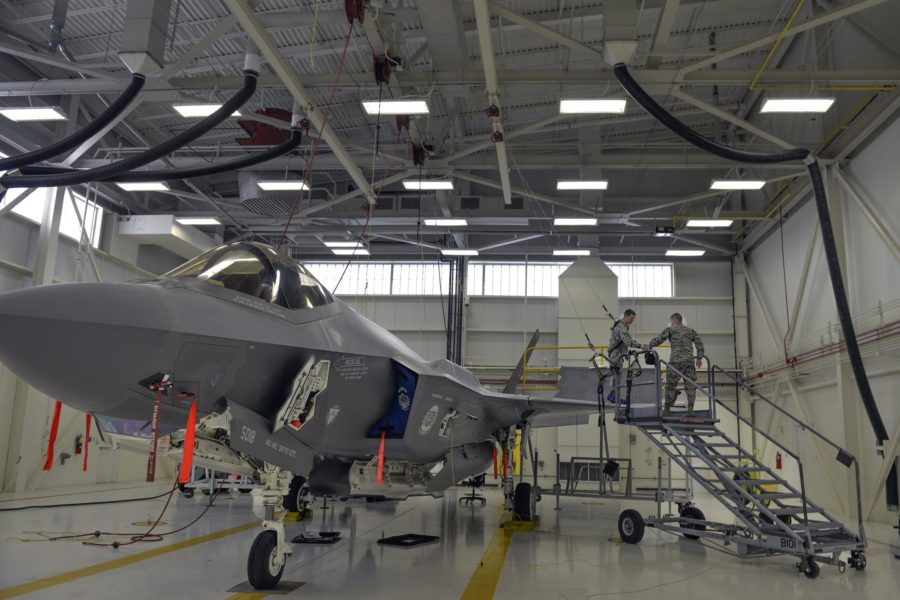Lockheed Martin must give up proprietary technical data in order to have a chance at long-term performance-based logistics contracts in support of the F-35 fighter, the program executive officer said. If the company fails to satisfy on an initial version of the arrangement, the military services likely will take over more of the jet’s maintenance enterprise.
Lt. Gen. Eric T. Fick, speaking with reporters Sept. 15, said Lockheed Martin got its big maintenance contract this week—worth up to $6.6 billion—with the proviso that it will transfer “provisioning and cataloging data” to the government before a full-up PBL contract is negotiated. If the company performs well on a “skinny” version of the PBL, the government will likely sign up for more. If not, the government will have the data it needs to bring more of the F-35 maintenance enterprise in house, Fick said.
Lockheed Martin pitched the PBL to then-Pentagon Undersecretary for Acquisition and Technology Ellen Lord in September 2019. The Joint Program Office, F-35 users, and the rest of the F-35 “community” assessed it, and “there was a lot of reluctance” to go ahead, Fick said. At the time, the community was “unsatisfied” with how the company was doing on F-35 sustainment.
After a review of options ranging from a “tip-to-tail PBL to standard, annualized, year-over-year contracts,” the community, headed by then-Navy acquisition executive James F. Geurts, decided that “we … as a Department … did not want to be trapped into a bad deal, for the schedule to be weaponized, and for us to have to sign a bad PBL,” Fick said.
Instead, the Pentagon chose a middle path, “where you could achieve most of the benefits of a [PBL] contract by focusing just on the supply chain management and the demand reduction piece,” he said. This mechanism seemed to offer the best return on investment, he added.
The rest of the work could then be offloaded to “a companion contract … more on an annualized basis,” Fick continued. “And so, the recommendation was to pursue that kind of approach. Lockheed, I think, referred to that as a ‘skinny’ PBL. Those were their words.”
“Back in the spring of 2020, we wrote [a memorandum of understanding]”—signed by Fick, Geurts, Air Force acquisition executive Will Roper, and Lockheed Martin’s then-general manager of the F-35 Greg Ulmer—“that really charted a … path [outlining] … what were the things required for us to actually move forward,” Fick said. One of them was the contract awarded this week, which gives Lockheed Martin an initial PBL for 2021, with options for fiscal 2022 and 2023.
“We’re going to start off with a three-year base plus two-year contract—that sets us on a glideslope that moves in the right directions.” If it works out, “we’ll start from a good launch-off point that puts us on the trajectory we think the Department should be on,” Fick explained.
But of it doesn’t work out, the Pentagon “wants options,” he said.
Under the “way the program was established, based upon the TSPR [Total System Performance Responsibility] construct,” the government didn’t get “all the data that we would have, if we had started the program in a more organically focused” way.
So, the MOU mandates that Lockheed Martin provide that “provisioning and cataloging” data, which would allow the services to take over “more of the supply chain management” if the company fails to perform.
“We’re using the incentive of the PBL to get decent pricing on the tech data required, so that at the end of that PBL, the services have an option for moving forward.”
If Lockheed Martin “kills it” and performs well, “and we’d love to stay there, then I think we’ve laid a great groundwork for a second PBL,” Fick said. “If not—if the services and the department and partners are unsatisfied—we have an option to do something different.” He said it is unlikely the F-35’s maintenance would be competed among other contractors.
After the three-year opening effort, Lockheed Martin would get its first PBL from fiscal 2023 to 2027, Fick said. But he hastened to add that the initial PBL is “not a done deal” and there’s no guarantee that the 2022 and 2023 options will be exercised.
Fick also said that while F-35 production Lots 15-17 are in negotiation now, a contract does not have to be inked by the end of the this month, which is the end of the fiscal year. “I’d love to get it done in October,” he said, but he declined to estimate how many aircraft would be in the mix, except to say the figure will “make sense” based on “what has gone before.”
